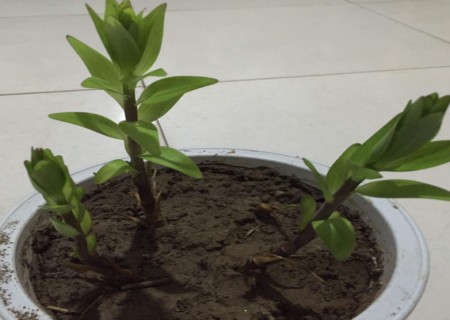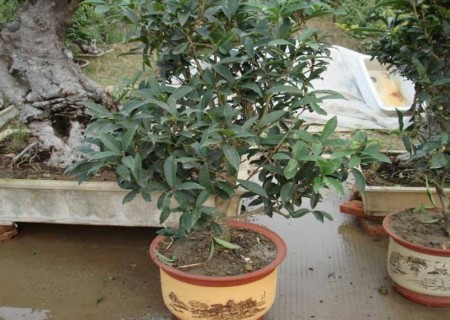Technical diagram of high pressure branches of pomegranate bonsai
Pomegranate is soft and easy to shape, so it is a good tree species for rapid prototyping to make bonsai. The method of cultivating pomegranate bonsai with high pressure method according to the characteristics of strong germination, high survival rate and easy cultivation of pomegranate, the traditional "branch pressing method" was used to select high pressure branches of pomegranate trees in order to obtain pile materials with better shape. the quick effect is extremely ideal.

The so-called high pressure branch is to select the branch suitable for making bonsai at the high place of the pomegranate tree to press the branch. That is, under the condition that the branches are not separated from the mother, they are first girdled, and then put into the soil in plastic bags or other utensils to promote the rooting of the girdling part, and then separate from the mother to become an independent new plant.
The effect of this method is faster and better than the general pressing method, and a pomegranate bonsai with hanging fruit can be obtained in the same year. The specific practices are as follows:
1. Pressing time
In order to achieve the effect of hanging fruit in that year, the time of pressing branches should not be too late, it is best when the sap begins to flow in early March every year, it is too late to take root, even if it takes root, it is not easy to survive after planting, not to mention hanging fruit in that year.
2. Girdling
According to the thickness of the selected branch, the bark is peeled around where it needs to be intercepted, the depth is up to the xylem, and the width is more than twice the diameter of the branch. For example, the width of the branch with a diameter of 2 cm to 3 cm is about 4 cm to 6 cm. The bark should be ring-peeled, otherwise it is not easy to take root.
3. Fill
The plastic film is wrapped and ligated under the ring stripping belt, and the plant material is filled with coarse sand or configured plant material, which is mainly permeable and breathable to facilitate rooting. Then pour enough water and tie up the mouth. Usually we should observe frequently and find that the lack of water is immediately watered through to ensure that the plant material is moist and conducive to hair roots.
4. Intercept
When it is found that there are white new roots growing in the plant, the branches can be cut irregularly with scissors or saws in the lower part of the selected branches, not too strong each time, so as not to affect the growth of the new roots. At the end of June and the beginning of July, the general area begins to enter the rainy season, which is also the time when the plant grows fastest. When the new root system is full of plant material, choose a cloudy day or light rain weather, cut the branches quickly with scissors, the action should be light and steady, the film and soil mass should not be loose.
5. Planting
After the branches are cut off, the soil should be put intact into the pre-prepared flowerpot, then unbind the film, fill the soil, and pour enough water to wait for growth.
6. Maintenance
Do not expose yourself to the sun after planting, first maintain it in a shady environment, and then gradually increase the light. Cut off some branches and leaves to reduce transpiration. When the air is dry, pay attention to foliar spraying and surrounding ground spraying to maintain a certain degree of humidity. In addition, do not leave too much fruit, at that time is mainly for the cultivation of trees, the fruit is still the second.
Netizens' experience sharing:
Some cultivated soil was added to the river sand. Pure river sand can be used for pomegranate high pressure matrix. The substrate is arranged in this way. if you want high-pressure seedlings to grow on the mother plant for a longer period of time, add some aerobic culture soil, and if it is directly cut off after rooting, you can use river sand directly.
If you make bonsai material for use, you often have to consider the tree potential and minimize the forming time. After taking root under high pressure, the new root is still relatively weak, if the pot plant is cut off immediately, there is no problem with survival, but there is a period of growth recovery period after potting, during which the tree is relatively weak and grows very slowly.
One way is not to cut off after rooting, let the high-pressure branches continue to let the mother plant "breast-feed", so that its own root system continues to strengthen, and the tree potential is guaranteed to the maximum extent.
In cloudy and rainy weather, cut the plastic bowl to have a look, the tender root system seems to be very good, boldly sawed off and put on the basin, try the pomegranate high pressure resistance.
But the whole process should be very careful, tender roots are very fragile, carefully pots, carefully fixed, carefully thinning branches, buds, leaves …...
The whole process is only 20 days, high pressure is a safe and reliable means of reproduction, can accelerate the growth of materials, and is a shortcut to the rapid development of bonsai materials.
The same material deduces a different artistic conception of fairy tales; just like the same happy life, it has different ways of expression. May you use your hands to create your own happiness and happiness.
Time: 2019-05-24 Click:
- Prev

Planting methods of potted lilies
Lily is native to Eurasia and North America and is distributed in Hubei, Shaanxi, Shanxi, Henan and Hebei provinces in China. Lily has become one of the five famous fresh cut flowers because of its large flowers, colorful, dignified and graceful posture, which can be watched in pots or arranged in flower mirrors in flower beds. Its bulb is fresh and tender and rich in nutrition.
- Next

Planting techniques of Osmanthus fragrans in four Seasons
In recent years, the newly emerged four Seasons Osmanthus has become a rising star in the sweet-scented osmanthus family. It breaks the general practice of sweet-scented osmanthus varieties blooming only once a year, and can blossom 4 times a year in February, May, August and November, usually with a flowering period of more than 20 days per season. The flowers are dense and yellow and white
Related
- Fuxing push coffee new agricultural production and marketing class: lack of small-scale processing plants
- Jujube rice field leisure farm deep ploughing Yilan for five years to create a space for organic food and play
- Nongyu Farm-A trial of organic papaya for brave women with advanced technology
- Four points for attention in the prevention and control of diseases and insect pests of edible fungi
- How to add nutrient solution to Edible Fungi
- Is there any good way to control edible fungus mites?
- Open Inoculation Technology of Edible Fungi
- Is there any clever way to use fertilizer for edible fungus in winter?
- What agents are used to kill the pathogens of edible fungi in the mushroom shed?
- Rapid drying of Edible Fungi

